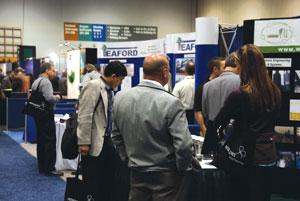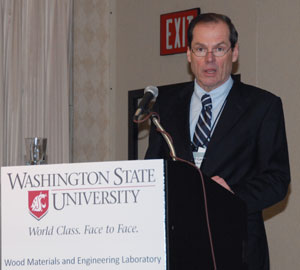
It’s Hot up North
August 10, 2009
By Bill Tice
Biomass and bioenergy are hot topics these days. There has been so much interest in the sector over the last couple of years that entire conferences are being dedicated to the topic at a breakneck pace. And even at conferences targeted at other industries, such as the ailing forest industry, biomass is stealing the show.
Biomass and bioenergy are hot topics these days. There has been so much interest in the sector over the last couple of years that entire conferences are being dedicated to the topic at a breakneck pace. And even at conferences targeted at other industries, such as the ailing forest industry, biomass is stealing the show.
 |
|
| In his keynote address at the International Wood Composites Symposium in Seattle, Washington, Wolf-Gerd Dieffenbacher told the audience he is concerned about the amount of residual fibre being directed towards the biomass industry.
|
Just look at the Washington State University’s 43rd International Wood Composites Symposium in Seattle at the end of March. Several speakers introduced biomass and bioenergy into their presentations and even keynote speaker Wolf-Gerd Dieffenbacher, president and CEO of the German wood panel press system manufacturer Dieffenbacher, dedicated a large portion of his address to biomass. However, Dieffenbacher’s comments on biomass were not all positive. He told the audience of about 150 industry, government and academic research representatives that he is concerned about the amount of residual fibre that is being directed towards the biomass industry, but he did stress there is an opportunity to work together.
“We see governments strive to get independent from fossil fuels and therefore promote the production of energy from renewable resources,” he said. “Biomass power plants and the pellet plants buy the same raw material as the panel industry does and because of subsidies they get better prices.”
Dieffenbacher did emphasize that the production of wood based panels provides an ideal partnership opportunity for a biomass power plant that could optimize the raw material and the heat energy usage. He concluded that governments support the production of green energy and that the panel industry can and should participate.Jerrold Winandy, a principal at Winandy and Associates, LLC in Mazomanie,
Wisconsin, followed not long after Dieffenbacher, telling the audience about integrated biomass technologies. He says this holistic view of how to achieve high-value materials with enhanced performance properties from renewable resources is an integrated concept that promotes the use of sustainable, bio-based, environmentally neutral technologies to meet global demands for building and materials end uses, chemicals and energy.
Other International Wood Composites Symposium conference speakers covering biomass included Shijie Liu, the associate director of the Biorefinery Research in Syracuse, New York. Liu and his research partner, Thomas Amidon, director of the Biorefinery Research Institute, note that biomass is a reliable source of materials, chemicals and energy that can be replenished at the rate of our needs. They say the biorefinery is a concept for the collection of processes used to convert biomass to materials, chemicals and energy and that the biorefinery is a “catch and release” way of using carbon that is beneficial to the environment and the economy.
International Biomass
Portland, Oregon, played host to the International Biomass Conference & Expo in late April. The three-day event that was entirely focused on biomass attracted 1,035 participants, which was a 20% increase over the 2008 show held in Minneapolis, Minnesota. Exhibitors at the “sold out” expo profiled their products at over 130 booths, while on the main stages approximately 90 speakers presented on six different tracks.
One of the tracks was specific to the forest industry. Entitled “Forest and Wood Processing Residues,” speakers from Canada, the U.S. and overseas covered topics such as woody biomass from public and private forest lands, increasing competition for wood biomass, and the greenhouse gas emissions and energy associated with wood pellets. Another track called “Dedicated Energy Crops” included forest industry content with speakers discussing topics such as dedicated tree farms and next generation biofuel feedstocks. The other tracks were Crop Residues, Livestock and Poultry Wastes, MSW, Urban Wastes and Landfill Gas, and Food Processing Residues. Participants could customize their agenda by switching tracks at any time during the conference.
The event was kicked off with a welcome address by Oregon governor Ted Kulongoski, which was followed by the keynote address by Robert Cleaves, president of the Biomass Power Association. The rest of the opening morning was dedicated to a discussion on how the U.S. Stimulus Bill and other federal policy developments will impact biomass, and a session on biomass project financing. Time for networking and visiting the product expo was also included in the schedule. The conference will move back to Minneapolis next year, and will be held from May 4 to 6.
 |
|
| For this year’s International Biomass Conference and Expo in Portland, Oregon, organizers sold out of trade show space and welcomed more than 1,000 people to the event. |
Biomass North
Just two weeks after the Portland event, the BC Bioenergy Network and its partners presented the BC Bioenergy Conference. The one day event was held in conjunction with the PricewaterhouseCoopers (PWC) 22nd annual Global Forest & Paper Industry Conference 2009 at Vancouver’s Bayshore hotel. Following the opening remarks, the audience listened to presentations on the future of bioenergy, a moderated discussion entitled “Regulate, Innovate, Activate: Lessons from BC and Beyond,” and a roundtable session on building a world class bioenergy industry.
Approximately 20 speakers and moderators from North America and overseas offered their opinions. The panels were composed of representatives from the academic world, government, corporations, industry associations and power companies.
At the PWC conference the previous day, a full house of almost 400 attendees listened to presentations on numerous topics, including biomass. Several of the presenters touched on the topic but Mike Burnside, president and CEO of Catchlight Energy LLC in San Francisco, California. tackled it head on. Catchlight is a joint venture company between Chevron and Weyerhaeuser that was formed in February of last year.
“I think at this point we are somewhat unique in the market in that we span the entire breadth of the value chain of forest to fuel,” he said. He also discussed some of the “hurdles and challenges” facing the industry. “In this area it is incumbent on the industry and its players to be open and transparent because in the end we have to convince a skeptical public and policy makers that in fact they need biomass to create green transportation tools, and that green energy is more sustainable on an overall basis.”
A number of biomass and bioenergy conferences and trade shows are being held throughout the year. Locations include Europe, Asia, South America, the U.S. and Canada. The Canadian shows will be held in Montreal, in July and in Quebec City and Moncton, New Brunswick, in September.•
Print this page